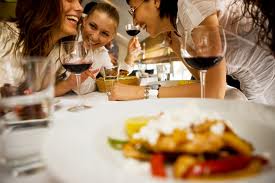 5 Ways to Save Money When You Eat Out
5 Ways to Save Money When You Eat Out
Source: http://www.dailyfinance.com/2013/07/09/save-money-dining-out-restaurants/
One reason why so many people resist making a household budget is that they think they’ll have to give up on simple pleasures like going to restaurants. But the better, more realistic approach is to let yourself spend some money on things like eating out while doing what you can to get the best value. That way, as the saying goes, you can have your cake and eat it too.
Here are some easy ways you can make your eating-out dollars go further — simple tips to help you cut your dining bill while still providing the experience you crave.
1. Eat Lunch, Not Dinner
If you’ve ever compared lunch and dinner menus, you’ll often find that they include the same items, but at much lower prices at lunch. For instance, the tres-chic New York restaurant Del Posto offers a five-course prix fixe dinner offering that will set you back $115, but a similar three-course prix fixe lunch costs just $39.
The reason: most restaurants, especially those near business districts, face far more competition at lunchtime, and faster turnarounds for those meals give them more room to cut their prices while preserving their profit margins. Lunch portions aren’t always as big, and often, the menu won’t have as many items to choose from, but eating out at midday can help you satisfy your cravings while spending less.
2. Pick the Right Day
Restaurant deals abound on the Internet, but restaurants have gotten smarter about how they offer them, limiting many special offers to low-traffic days of the week. Moreover, even eateries without any online presence at all often have daily specials, so check out your local establishments to see if your favorite meal is the bargain-du-jour on a particular weekday and save some money.
Quality can also be a factor. Celebrity chef Anthony Bourdain once said that he never orders fish on Monday, because most fish markets aren’t open on weekends and so by Monday, the seafood restaurants have on hand is three days old. By Tuesday, as the theory goes, new deliveries have replenished restaurant pantries. Bourdain has since watered down his earlier comment as food availability has changed, but taking similar factors into consideration can give you a better-quality dining experience.
3. Skip the Drinks
If you’ve ever noticed that the same soft drink you can buy from a store for 20 cents a can costs $2 or $3 even at some fast-food establishments, you’ve probably figured out what restaurant owners already know: Drinks are a huge source of profits. With wine and alcoholic beverages, it’s not unusual for customers to pay four or five times the restaurant’s wholesale price, with some of the biggest markups coming from the lowest-priced offerings on the menu. Once a restaurant handles high upfront costs like buying a carbonation system, soft drinks can be an even bigger cash cow: soda and syrup prices are minuscule compared to the menu price of your cola.
Ordering tap water or bringing your own beverage — even if you have to pay a modest corking fee — can save you a bundle.
4. Don’t Judge a Restaurant By Its Storefront
Just like any business, restaurants have to cover their overhead. So when you eat in elegant surroundings in high-rent districts, you can count on paying the price. Conversely, dining at hole-in-the-wall locations, strip malls or even food-concession trailers lets you benefit from their minimal overhead.
Admittedly, some restaurants in low-rent locations also have low quality, but thanks to the ubiquity of online reviews and guides, it’s easier than ever to cull out the hidden gems from the places you should avoid at all costs.
5. Save Eating Out for Special Food
When you’re on a budget, eating out becomes a special occasion. So treat it like one by choosing foods you can’t or won’t cook at home.
Popular items like burgers often carry higher markups over cost than more expensive menu items, and sticking to the highest-quality items can give you more bang for your buck and prevent eating out from becoming just a high-cost substitute with no better quality than the food you eat at home.
One great example of this phenomenon comes from the kids’ menu. Kraft Foods (KRFT) specifically solicits restaurants to add its Macaroni & Cheese to their menus, arguing that “it’s sure to keep kids happy and drive traffic as families return to your restaurant again and again.” But rather than paying $5 for a small portion of that at a restaurant, encourage your kids to make more interesting and better-value selections, and pick another night to spend $1 or less for a whole box at home.
